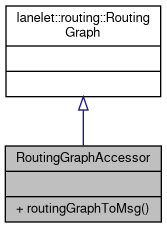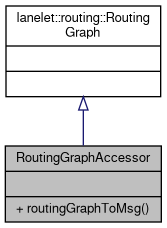This class serves as a method of exposing the internal protected members of the lanelet2 RoutingGraph. This allows for a conversion method to be written which converts the routing graph to a ROS message representation. More...
#include <RoutingGraphAccessor.hpp>


Public Member Functions | |
| autoware_lanelet2_msgs::msg::RoutingGraph | routingGraphToMsg (const std::string &participant) |
| Returns a ROS message version of this RoutingGraph. This is done by accessing protected data members directly. More... | |
Detailed Description
This class serves as a method of exposing the internal protected members of the lanelet2 RoutingGraph. This allows for a conversion method to be written which converts the routing graph to a ROS message representation.
ASSUMPTION: Note this class is heavily dependant on the non-public implementation API of lanelet2 (v1.1.1). Any change to the underlying data structures may negatively impact this classes performance or ability to compile.
Definition at line 32 of file RoutingGraphAccessor.hpp.
Member Function Documentation
◆ routingGraphToMsg()
|
inline |
Returns a ROS message version of this RoutingGraph. This is done by accessing protected data members directly.
- Parameters
-
participant The participant which was used to build this routing graph. NOTE: This is not a choice. This must match the value used to generate this object.
- Returns
- The ros message which can be used to regenerate this routing graph structure.
Definition at line 44 of file RoutingGraphAccessor.hpp.
References sci_strategic_plugin::Left, and sci_strategic_plugin::Right.
The documentation for this class was generated from the following file:
- carma_wm_ctrl/src/RoutingGraphAccessor.hpp